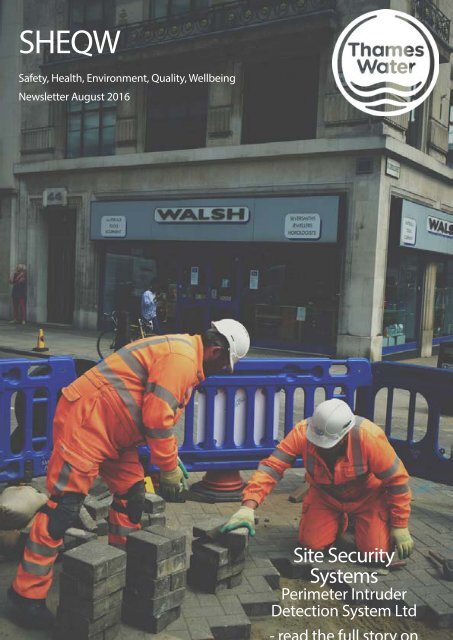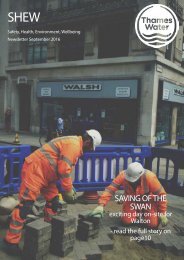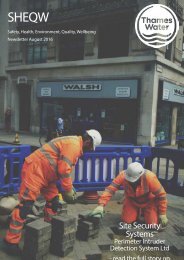SHEQWs Newsletter August
You also want an ePaper? Increase the reach of your titles
YUMPU automatically turns print PDFs into web optimized ePapers that Google loves.
SHEQW<br />
Safety, Health, Environment, Quality, Wellbeing<br />
<strong>Newsletter</strong> <strong>August</strong> 2016<br />
Site Security<br />
Systems<br />
Perimeter Intruder<br />
Detection System Ltd
Contents<br />
3. What we could do better<br />
Virtual Trial Holing<br />
4. Movement of Plant<br />
We reflect on how we can control the<br />
movement of plant following an incident<br />
(not on eight 2<br />
O)<br />
5. In the Courts<br />
Looking at inspections and Latest<br />
environmental prosecution<br />
6. Topic of the Month<br />
Working on previously developed land<br />
10. xx<br />
xx<br />
10. In the spotlight<br />
Ecologists go surveying for Great Crested<br />
Newts<br />
12. What’s been happening<br />
We look at the raft race, notice boards<br />
and HAVS workshops last month<br />
14. Site security<br />
We look at how one project has<br />
optimised their site security<br />
15. SMB reporting<br />
Latest SHE statistics<br />
16. Safety alerts<br />
Latest safety alerts for dissemination<br />
What we could<br />
do better<br />
Use of BIM:<br />
Virtual Trial Holes<br />
What are Virtual Trial Holes<br />
Trial holes can be carried out<br />
without accurate knowledge of<br />
what lies beneath the ground,<br />
leaving operatives open to risks of<br />
contaminated ground,un-mapped<br />
underground services, side wall<br />
collapse and many other health and<br />
safety concerns.<br />
Virtual trial holes can eliminate these<br />
concerns and even the requirement<br />
to break ground.<br />
GPR (Ground Penetrating Radar)<br />
surveys can be carried out at ground<br />
level and the results can then be<br />
analysed by design.<br />
REMEMBER - this does not eliminate<br />
the requirement for soil analysis<br />
if ground needs to be broken in<br />
potentially contaminated land.<br />
Benefits of this method<br />
• No digging<br />
• Reduced costs (e.g. excavators,<br />
banksmen, permits etc.)<br />
• Reduced time<br />
• Increased safety<br />
Watch virtual trial holes<br />
video<br />
Page 2 | <strong>August</strong> 2016 SHEWQ <strong>Newsletter</strong><br />
SHEWQ <strong>Newsletter</strong><br />
<strong>August</strong> 2016 | Page 3
Controlling the movement<br />
of plant<br />
Remember the following<br />
when managing<br />
machinery on trailers;<br />
• Leave the trailer attached to the<br />
vehicle where possible<br />
• Use chocks (wooden stoppers)<br />
underneath wheels of trailer<br />
• Park trailer in a safe place<br />
• Ensure hand break is on<br />
• Be vigilant of the location/ risk of<br />
unhitching trailers - e.g is it on a<br />
slope, is it a safe location etc.<br />
Incident Example:<br />
Uncontrolled movement of<br />
plant, Nottingham<br />
Whilst delivering a mini digger for<br />
deep excavation works, an operative<br />
unhitched the trailer with the mini<br />
digger still loaded. The trailer became<br />
uncontrolled and free wheeled down<br />
the incline.<br />
After travelling for approximately<br />
25-30m down the incline, the trailer<br />
struck a parked vehicle causing<br />
damage.<br />
Action taken;<br />
• Trailer made safe<br />
• Supervisor informed<br />
• SHE team undertook<br />
investigation<br />
In the courts<br />
Water Company &<br />
subcontractor fined<br />
almost £1 million<br />
A water company has been fined<br />
£600,000, its contractor £333,000<br />
and additional clean up costs of<br />
£45,262 after polluting a brook.<br />
The contractor was carrying out<br />
works on a treatment works, which<br />
involved emptying and removing<br />
a tank used to store sodium<br />
hypochlorite. Sodium hypochlorite<br />
is used in the water purification<br />
process and is also the principle<br />
ingredient of household bleach.<br />
In 2013, the majority of the contents<br />
of the tank had been removed, but<br />
up to 300 litres of the highly toxic<br />
chemical was left in the bottom<br />
awaiting emptying. The Environment<br />
Agency stated that instead of<br />
pumping the remaining liquid out,<br />
a hosepipe was used to dilute the<br />
sodium hypochlorite with water.<br />
The hosepipe was then left running<br />
unattended overnight, letting it flow<br />
into a bunded area. This was carried<br />
out without any risk assessment or<br />
method statement.<br />
Neither company had surveyed the<br />
drainage to identify faults in the<br />
drainage system. This meant that the<br />
diluted toxic chemical entered the<br />
surface water drainage system and<br />
discharged to Bradshaw Brook.<br />
Two days later the Environment<br />
Agency were alerted that a 1.7km<br />
stretch of the brook was so badly<br />
polluted, killing virtually all aquatic<br />
organisms, including up to 900 fish,<br />
shrimp and earthworms.<br />
This case should bring home the<br />
message to all company directors<br />
and shareholders that environmental<br />
offences are taken seriously both by<br />
the regulators and the courts.<br />
(The Environmentalist, 2016)<br />
Page 4 | <strong>August</strong> 2016 SHEWQ <strong>Newsletter</strong><br />
SHEWQ <strong>Newsletter</strong><br />
July 2016 | Page 5
Working on Previously Developed<br />
Land<br />
What is previously<br />
developed land?<br />
• Land which has been previously<br />
been built on or used by<br />
industrial processes (brownfield),<br />
or land which in the past has had<br />
imported materials on it (made<br />
ground).<br />
• These may be contaminated<br />
with substances that are harmful<br />
to humans or the environment.<br />
Contaminants can be in solid<br />
(e.g. asbestos), liquid (e.g. oils) or<br />
gas (e.g. methane) form.<br />
• Contaminants can be discovered<br />
when they are not expected<br />
and so it is important to remain<br />
observant when excavating.<br />
How does this work on<br />
eight 2<br />
O?<br />
• During design an Environmental<br />
Assessment/ PE3PA is completed<br />
which gives land quality<br />
recommendations. This may<br />
stipulate the need for soil<br />
sampling or the need for the site<br />
teams to undertake a watching<br />
brief during works.<br />
• Soil sampling reduces the risk<br />
of finding contaminated land<br />
unexpectedly, but if these do not<br />
occur, we need to ensure that we<br />
are vigilant of any finds.<br />
Why do we need to monitor<br />
this?<br />
• Avoid Environmental harm:<br />
working in contaminated ground<br />
without the proper controls<br />
may result in pollution or the<br />
spread into surrounding land or<br />
watercourses.<br />
• Avoid prosecution: pollution<br />
escape can lead to prosecution<br />
• Reduce health hazard: exposure<br />
to certain contaminants may<br />
cause skin and/ or respiratory<br />
irritation, cancer or birth defects.<br />
Wearing the correct PPE can<br />
reduce these risk.<br />
• May result in incorrect<br />
classification of waste which is a<br />
prosecutable offence.<br />
How to identify<br />
contaminated land<br />
• Look out for changes to the type<br />
of material;<br />
• Differences in colours or texture<br />
• Presence of rubbish or other<br />
objects<br />
• Differences in smell<br />
• Fumes<br />
What to do if you find<br />
contaminated land<br />
• Stop work, make the area safe,<br />
cordon off and inform your<br />
supervisor<br />
• DO NOT allow anyone to enter<br />
area, unless authorised by a<br />
Supervisor<br />
• SMB Site Agent to report on BB<br />
Hotline/ CA schemes to Capture<br />
• Call your Environmental Advisor<br />
who will contact the land quality<br />
team to arrange soil sampling<br />
and ensure adequate disposal.<br />
• Inform your H&S Advisor who<br />
will inform you of any safety<br />
requirements.<br />
• Always wear full PPE for potential<br />
contaminants<br />
• Wash hands and exposed skin<br />
after working in excavations<br />
• Prevent soil runoff into drains<br />
and watercourses<br />
Page 6 | <strong>August</strong> 2016 SHEWQ <strong>Newsletter</strong><br />
SHEWQ <strong>Newsletter</strong><br />
<strong>August</strong> 2016 | Page 7
In the spotlight<br />
Ecologists go surveying for Great Crested Newts<br />
SMB ecologists Gareth<br />
Lavery and David<br />
Macknay have been<br />
especially busy over the<br />
spring survey window<br />
undertaking newt surveys<br />
in potential breeding<br />
ponds and ditches, in<br />
order to inform design<br />
and/ or apply for a licence<br />
on various projects.<br />
Results of this year’s<br />
surveys: locations with GCN<br />
presence<br />
• D339 Newbury STW<br />
• D339 Carterton STW<br />
• D339 Moreton-in-Marsh STW<br />
• C946 Faringdon to Blunsdon<br />
pipeline<br />
• D018 Goose Green<br />
• D332 Stewkley STW.<br />
How to identify the<br />
presence of Great Crested<br />
Newts (GCN)<br />
Four surveys are required to<br />
determine the absence of GCN, with<br />
at least 3 of the 4 survey methods<br />
being utilised. These are;<br />
• Bottle Trap - placing traps in the<br />
pond and leaving overnight<br />
• Torching – searching for GCN at<br />
night via torchlight<br />
• Egg Search – searching leaves for<br />
signs of eggs<br />
• Netting – net used to search<br />
perimeter of pond<br />
If whilst undertaking these four<br />
surveys GCN are discovered, the<br />
survey number increase to six, in<br />
order to get a population count. This<br />
is normally 6 bottle tap and torch<br />
surveys.<br />
New Technology - EDNA<br />
eDNA water samples identifies GCN<br />
DNA. This year 73 eDNA kits were<br />
used on 22 upcoming project sites.<br />
The benefits of this new<br />
technique are:<br />
Major cost reduction over the AMP<br />
(estimated at c. £500,000)<br />
Reduced health and safety risk to<br />
personnel as less night-time work in,<br />
and next to, water<br />
Early identification which helps<br />
reduce programme delays,<br />
aid Project Managers and helps<br />
understand potential impact on<br />
VOWD (Value of Work Delivered)<br />
What happens if GCN<br />
presence is confirmed?<br />
If identified during design, the<br />
environmental team will work with<br />
the design team to attempt to<br />
“design out” the issue by locating<br />
new works to avoid their habitat<br />
(scrub, established grassland,<br />
woodland edge etc.)<br />
If Ops identify GCN onsite, the<br />
ecologist will undertake a visit<br />
to determine this. For example,<br />
at Chesham STW, Ops identified<br />
GCN, but after a visit, our ecologist<br />
identified these as non-protected<br />
smooth newts.<br />
On Thames Valley Mains Rehab Year<br />
2, SMB have the luxury of dropping<br />
schemes that have confirmed or<br />
Page 8 | <strong>August</strong> 2016 SHEWQ <strong>Newsletter</strong><br />
SHEWQ <strong>Newsletter</strong><br />
<strong>August</strong> 2016 | Page 9
What’s been happening across<br />
eight 2<br />
O<br />
Thames Water Raft Race<br />
This year marked Thames Water’s<br />
20th Annual Raft Race for<br />
WaterAid. Over the next four years,<br />
eight2O and Thames Water will be<br />
working together with WaterAid<br />
to transform lives in two towns in<br />
Malawi - the world’s poorest country.<br />
Currently in Malawi, 10 million<br />
people have no safe place to go to<br />
the toilet and 1.7 million people have<br />
no access to safe, clean water.<br />
In light of this, in July, 7 eight2O<br />
rafts, including 2 from the SHE Team<br />
entered the annual one mile raft race.<br />
34 carnival themed rafts battled it<br />
out on the River Thames. Each team<br />
designed, built and decorated their<br />
raft and wore fancy dress based<br />
around the theme of carnival.<br />
SHE Ream populate RKC<br />
notice board<br />
In July the SHE team populated the<br />
notice board in F2 RKC.<br />
This is a Thames Water initiative,<br />
pushed by Richard Blake to ensure key<br />
messages are being received by all<br />
staff.<br />
After many hours of discussions,<br />
meetings and deliberation we decided<br />
that the SHE message would be “ SHE<br />
in the Planning stage”, through a game<br />
of<br />
SHE Snakes and Ladders and the<br />
Pillars of SHE Genga.<br />
If you didn’t get to see it and would<br />
like to, get in touch.<br />
Occupational Health -<br />
HAVS workshops<br />
The Occupational Health Team have<br />
been busy doing workshops to raise<br />
awareness of the causes, symptoms<br />
and prevention methods of HAVS,<br />
across a number of sites.<br />
It has been acknowledged that a<br />
large percentage of the workforce<br />
do not understand exposure points<br />
and permitted times for tool usage.<br />
Additionally, it has been identified<br />
that exposure records are not being<br />
kept correctly and many were<br />
occurring after the activity had<br />
happened. .<br />
If any sites would like this workshop<br />
carried out, get in contact with the<br />
occupational health team or speak to<br />
It was a spectacular day & no eight2O<br />
team sunk!!<br />
If you would like to donate,<br />
please do so, click here.<br />
If you want a copy of the<br />
comic, please email us.<br />
Page 10 | <strong>August</strong> 2016 SHEWQ <strong>Newsletter</strong><br />
SHEWQ <strong>Newsletter</strong><br />
<strong>August</strong> 2016 | Page 11
July’s SMB Reporting Figures<br />
The OneView app effectively replaces cumbersome stat packs with a cloud-based document management/viewer<br />
system. And the photo-driven Corona app provides real-time H&S reporting and the backbone for the Works<br />
Management System.<br />
98%<br />
51%<br />
Site Security System<br />
Perimeter Intruder Detection Systems Ltd<br />
The PID system was first introduced<br />
on the CAJV by Trant Engineering on<br />
the Cirencester STW Investigation<br />
project, due to plant damage over a<br />
weekend period.<br />
The PID System triggers any<br />
disturbance and alerts a manned<br />
centre. This includes a bespoke<br />
site specific protocol to ensure<br />
authenticity. Depending upon the<br />
activity witnessed via the cameras,<br />
this can be escalated directly from<br />
the monitoring station to the nearest<br />
police station prior to notifying the<br />
designated site contact.<br />
The benefits of this system<br />
are;<br />
• Audible warning<br />
• Flashing lights<br />
• Camera which photographs<br />
(to provide notification and<br />
evidence)<br />
• Notification to 24hr manned<br />
centre<br />
Success! - Once this system was<br />
introduced it had a 100% success rate<br />
and no further incidents occurred.<br />
“PID Systems is a market<br />
leading supplier of bespoke<br />
security products designed<br />
to meet the unique<br />
challenges of the civil<br />
engineering construction<br />
100%<br />
Diversion of Excavated Material<br />
from landfill vs Target<br />
51<br />
3<br />
Noise<br />
Asbestos<br />
Trip or slip hazard<br />
1<br />
1<br />
2<br />
90%<br />
Recycled aggregate use<br />
It is the responsibility of the construction team<br />
to ensure that our subcontractors are using<br />
facilities which maximise recycling.<br />
Every month reporting data is extracted from<br />
Safeguard and the BB Hotline.<br />
Whether a service strike, incident, near miss or<br />
hazard, it is all incredibly important to us.<br />
Near miss - utility<br />
Completed H&S Inspections<br />
170<br />
Please ensure that you are completing your<br />
inspections on safeguard. These are crucial in<br />
identifying hazards and reducing the risk of an<br />
incident on site.<br />
We are getting better ... but we are not<br />
reaching our target yet!<br />
Page 12 | <strong>August</strong> 2016<br />
SHEWQ <strong>Newsletter</strong><br />
SHEWQ <strong>Newsletter</strong><br />
<strong>August</strong> 2016 | Page 13
SAFETY ALERTS<br />
LIFTING &<br />
EXCAVATORS<br />
POWER SUPPLIES<br />
TO CABINS<br />
Select each safety alert to download to your device. If you<br />
are briefing out to your colleagues download DW01F04, fill<br />
out and return to the H&S safety team.<br />
DW01F04<br />
SA 11KV CABLE<br />
STRIKE<br />
LIFTING &<br />
EXCAVATORS 2<br />
SHE LESSONS<br />
LEARNT<br />
CHOLSEY<br />
UNSAFE CABLE<br />
CUTTING<br />
CHLORINE<br />
GAS DISCHARGE<br />
SHE LESSONS LEARNT<br />
PROTECTION<br />
Page 14 | May 2016 Take care<br />
May 2016 | Page 15
Passionate about everything we do

















